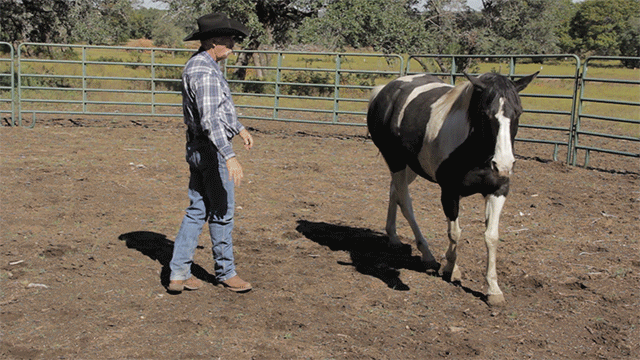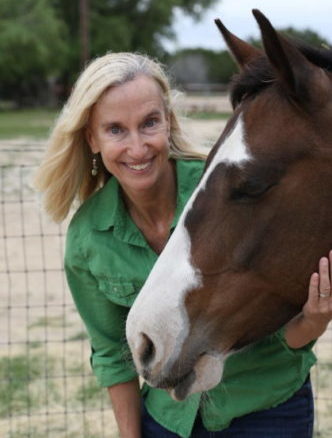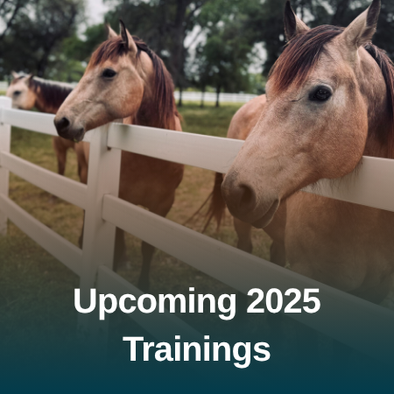. . . Does Connection Really Matter?
Frieda kicked out, ears back, black and white tail lifted high. She was clearly not happy about the pressure that Natural Lifemanship founder and Equine Professional Tim Jobe was putting on her to ask for connection. Tim explained that Frieda had spent the whole 12 years of her life occupying a pasture near a mobile home park, where the residents and their children petted her and gave her apples. No one had ever asked her for anything in return, until now. Frieda started out by pointedly ignoring Tim when he began asking for attachment. When he brought his body energy up a bit and made a smooching sound with his lips, she promptly burst into a frenzy of bucking and kicking as if in disbelief that he would continue to make this (in her mind) ridiculous request. I watched Frieda’s spirited display of resistance, which reminded me of a child’s tantrum, while Tim continued to keep the pressure the same by maintaining his proximity to Frieda no matter where she went in the round pen and directing the same amount of body energy from his core, directed now towards her side, in a request for detachment (connection with some space, or a boundary).

One of the training participants asked if it wouldn’t be better for Frieda to be allowed to just continue enjoying her peaceful life of being petted and given treats. Why should we upset her by requesting something clearly only we humans wanted, and she did not seem to value at all? I thought about this question. I generally avoid conflict, and it can be difficult for me to ask for things in a relationship that I know might be considered inconvenient or difficult for the other person to give. I sometimes settle for less than I should in a situation simply because asking for what I need feels “too hard.” I felt a bit sorry for Frieda too, actually. In the weeks that followed, I did a great deal of soul searching about this principle of the Natural Lifemanship model: If it is not good for both parties in the relationship, it is not good for the relationship itself. How was asking for a connection from a human or horse who seemed unwilling and unhappy about giving it still good for the relationship? I came up with the following reasons:
1. Experiencing a healthy connection enhances the quality of life
Both humans and horses experience better physical, emotional, and mental health when they know how to have a positive connection with others. Connection builds cross brain connections which allow for responding (making choices from the neocortex informed by the limbic system) instead of reacting (from the brainstem where the only options are fight, flight, or freeze). Horses who are able to access the thinking part of their brain engage in fewer skirmishes in the herd, resulting in a decreased risk of injury from being kicked or bitten. The experience of connection in a relational context releases dopamine in the brain, which creates a feeling of well being. Humans also benefit from healthy connection: research shows that people with a strong social support network live longer with fewer health problems than those who are more isolated.
http://www.health.harvard.edu/newsletter_article/the-health-benefits-of-strong-relationships
2. Healthy connection creates positive interactions
Domestic horses depend on humans for food, shelter, and care. The more they can access their neocortex in cooperating with their human caregivers, the better their experiences with humans is likely to be. People respond more positively to friendly horses, keep them longer, and are able to give them the medical care they require if they are allowed to touch their ears, hooves, and other parts of the body to give medicine, as well as perform massage or other therapeutic touches. Horses who have not been helped to be comfortable with being touched all over their bodies may not receive the care they need when sick or injured. Reactive horses tend to have multiple owners and often end up in bad situations as people give up on trying to manage their behaviors. Connections between horses in the herd also change. Joey, a wild mustang at Spirit Reins, was not a part of the herd until clients began choosing him as their relationship horse. Now, Joey allows and engages in mutual grooming behaviors with some herd members. This has increased Joey’s safety and sense of well being as he becomes part of the herd.
3. Healthy connection heals trauma
Both humans and horses may avoid intimacy because they have learned that relationships are a source of pain rather than comfort. At some point, they may have decided that requests for connection will only lead to harmful interactions, and find ways to avoid intimacy as a form of self-protection. Healing this broken pathway through patient, persistent work on attachment and detachment results in restoring trust in relationships as a safe place to be both seen and known. Our deepest desire as humans is to be fully known and fully accepted. Trauma destroys any hope that this is possible. Inviting connection using the principles of pressure rewires the brain to have a different response, unfreezing the trauma and allowing it to process through for both horses and humans.
https://www.brainpickings.org/2016/06/20/the-body-keeps-the-score-van-der-kolk/
4. Healthy connection helps with self-regulation
We can co-regulate with those whom we have positive, trusting relationships. Attunement in relationships allows us to give and receive comfort to each other. Any stressful situation immediately feels less overwhelming if we don’t feel so alone in it. Connection helps calm and soothe us when we are distressed.
http://www.cde.ca.gov/sp/cd/re/itf09socemodev.asp#emoreg
http://austinpublishinggroup.com/psychiatry-behavioral-sciences/fulltext/ajpbs-v1-id1021.php
5. Connection increases our capacity for joy
Biologically we are driven towards connection. Both human infants and foals depend upon their mothers or early caregivers for survival and learn how to get their needs met either in positive or negative ways depending upon the environment they are born into. Even those who struggle with intimacy due to abuse or neglect experience a consistent conflict around the internal drive to seek connection while simultaneously fearing the result of doing so. On a primal level we know we need relationships to survive, so we set about creating the only kinds of relationships we know how to have which often results in a serial pattern of maltreatment and heartbreak. As we rewire the brain through a healthy connection we increase our capacity to experience positive emotions which results in a positive synergy: positive connection building more cross brain connections which build more opportunity for positive connection. Symptoms of anxiety and depression diminish as deeper and more satisfying connections are achieved.
http://nautil.us/issue/28/2050/what-technology-cant-change-about-happiness
While it can seem more benevolent not to initiate or persist in asking for connection with a being who appears disinterested or resistant, I realized that avoiding the work of connection indicates a devaluing of self, the other, and the relationship. I am not seeing that I have enough inherent value to make the request, or that the horse/human has enough value for me to pursue them. In other words, if I am more interested in self-protection than pursuing the relationship I am choosing the relative comfort of isolation over the deeper comfort of intimacy. I am essentially demonstrating that the relationship is not worth investing my time and energy in and that I am not willing to risk initially being ignored and/or rejected as I seek to build the relationship.
When Frieda eventually tired of galloping and bucking around the ring, she slowed down and seemed to consider Tim’s quiet, persistent request for connection. She stopped and swung her beautiful head toward him, wide-eyed and snorting, ears flicking back and forth. Tim immediately stepped back to release the pressure and let Frieda know that her choice was good for the relationship. Frieda considered for a few moments longer, then took that long-awaited step towards Tim. He stepped back a bit more. Frieda changed her mind a few more times along the way, going back to ignoring and resisting, before realizing that maybe attachment felt better than running away. By the end of the session, Frieda was walking comfortably alongside Tim, resting her head on his arm occasionally, and turning her big brown eyes to him as if to say that this was her idea all along. Frieda finally realized that a healthy connection can feel safe and enjoyable.



Recent Comments